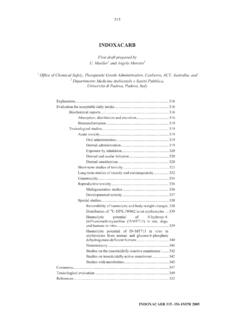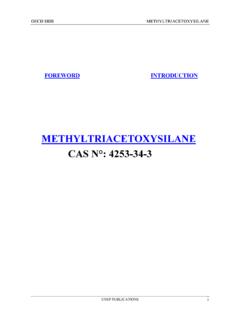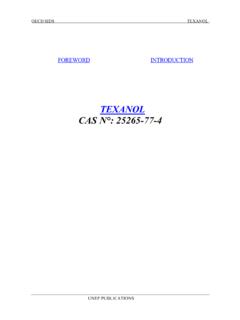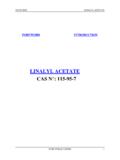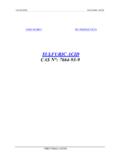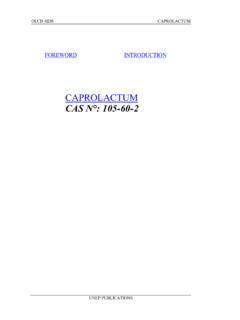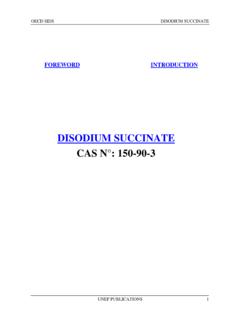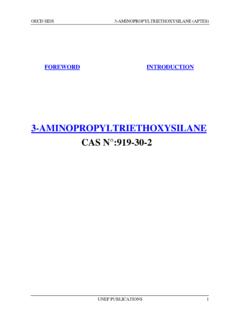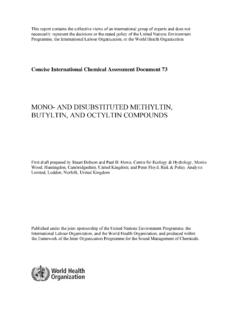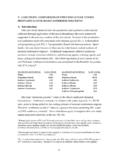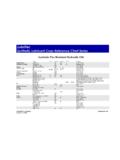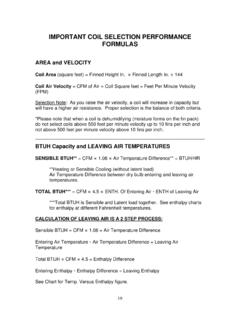Transcription of FOREWORD INTRODUCTION - INCHEM
1 OECD SIDS 1,2--DIHYDROXYPROPANE. FOREWORD INTRODUCTION . 1,2-DIHYDROXYPROPANE. CAS:57-55-6. UNEP PUBLICATIONS 1. OECD SIDS 1,2--DIHYDROXYPROPANE. SIDS Initial Assessment Report for 11th SIAM. (USA, January 23-26, 2001). Chemical Name : propylene glycol CAS No: 57-55-6. Sponsor Country: National SIDS Contact Point in Sponsor Country: Oscar Hernandez US EPA. 401 M St. Washington, DC 20460. HISTORY: At SIAM 11 the conclusion of Low Priority for Further Work was agreed. Revisions to the SIAR and preparation of Robust Summaries were requested and agreed. COMMENTS: Deadline for circulation: Date of Circulation: 2 UNEP PUBLICATIONS. OECD SIDS 1,2--DIHYDROXYPROPANE. SIDS INITIAL ASSESSMENT PROFILE. CAS No. 57-55-6. Chemical Name propylene glycol (1,2-dihydroxypropane). Structural Formula CH3 -CHOH-C H2 OH. RECOMMENDATIONS. The chemical is currently of low priority for further work. SUMMARY CONCLUSIONS OF THE SIAR.
2 Human Health propylene glycol (PG) is not acutely toxic. The lowest oral LD50 values range between 18 and grams (5 different species) and the reported dermal LD50 is grams. PG is essentially non- irritating to the skin and mildly irritating to the eyes. Numerous studies support that PG is not a skin sensitizer. Repeated exposures of rats to propylene glycol in drinking water or feed did not result in adverse effects at levels up to 10% in water (estimated at about 10 g/kg bw/day) or 5% in feed (dosage reported as g/kg bw/day) for periods up to 2 years. In cats, two studies of at least 90 days duration show that a species-specific effect of increased Heinz bodies was observed (NOAEL = 80 mg/kg bw/day; LOAEL = 443 mg/kg bw/day), with other haematological effects (decrease in number of erythrocytes and erythrocyte survival) reported at higher doses (6-12% in diet, g/cat/day). propylene glycol did not cause fetal or developmental toxicity in rats, mice, rabbits, or hamsters (NOAELs range from to g/kg bw/day in four species).
3 No reproductive effects were found when propylene glycol was administered at up to 5% in the drinking water (reported as g/kg bw/day) of mice. propylene glycol was not a genetic toxicant as demonstrated by a battery of in vivo (micronucleus, dominant lethal, chromosome aberration) and in vitro (bacterial and mammalian cells and cultures) studies. No increase in tumors was found in all tissues examined when propylene glycol was administered in the diet of rats ( g/kg bw/day for 2 years), or applied to the skin of female rats (100% PG; total dose not reported; 14 months) or mice (mouse dose estimated at about 2 g/kg bw/week;. lifetime). These data support a lack of carcinogenicity for PG. Environment propylene glycol is not volatile, but is miscible with water. Air monitoring data are not available, but concentrations of propylene glycol in the atmosphere are expected to be extremely low because of its low vapor pressure and high water solubility.
4 It is readily biodegraded in water or soil. Four studies reported >60% biodegradation in water in 10 days. PG is not expected to bioaccumulate, with a calculated BCF <1. Measured freshwater aquatic toxicity data for fish, daphnia and algae report LC/EC 50 values of >18,000 mg/l. Therefore, PG is not acutely toxic to aquatic organisms except at very high concentrations. Using an assessment factor of 100 and the Ceriodaphnia data (48- hour EC 50. = 18,340 mg/l), the PNEC is 183 mg/l. Exposure PG production capacity in the US was 1312 million pounds (596 kilotonnes) in 1998. Domestic demand was 1050 million pounds (477 kilotonnes). PG is used as an ingredient in cosmetics at concent rations of < to >50%. Approximately 4000 cosmetic products contained PG in 1994. Uses UNEP PUBLICATIONS 3. OECD SIDS 1,2--DIHYDROXYPROPANE. of PG, with percent of demand, are: unsaturated polyester resins, 26 percent; antifreeze and de- icing fluids, 22 percent; food, drug and cosmetics uses, 18 percent; liquid detergents, 11 percent; functional fluids (inks, specialty anti-freeze, de-icing lubricants), 4 percent; pet foods, 3 percent; paints and coatings, 5 percent; tobacco, 3 percent; miscellaneous, including plasticizer use, 8 percent.
5 NATURE OF FUR THER WORK RECOMMENDED. No further work is recommended. 4 UNEP PUBLICATIONS. OECD SIDS 1,2--DIHYDROXYPROPANE. FULL SIDS SUMMARY. CAS NO: 57-55-6 SPECIES PROTOCOL RESULTS. PHYSICAL-CHEMICAL. Melting Point -- NG < -60 C. NG < -57 C. Boiling Point -- NG C. Density -- NG g/cm3. Vapour Pressure -- NG hPa at 20 C. NG mm Hg Partition Coefficient -- NG ca. to (Log Ko w). A. Water Solubility -- NG Soluble at 25 C. B. PH -- -- Pka -- -- Oxidation:Reduction -- -- Potential ENVIRONMENTAL FATE. AND PATHWAY. Photodegradation -- Est. (AopWin v Half Life = hr ). Stability in Water -- -- -- Monitoring Data -- -- -- Transport and -- Fugacity model in air; in water; Distribution (Level III) in soil; in sediments. Biodegradation -- Other, APHA Readily biodegradable (79% after 20. 1971 days; aerobic, unacclimated sludge). -- NG Degraded (100% after 12 days;. aerobic, soil microorganisms -- NG Readily biodegradable (aerobic, 84- 99% after 24 hr; acclim.))
6 And unacclim. Sludge -- NG Degraded to methane by anaerobic soil organisms in sandy loam, but not in surface sand Bioaccumulation -- Calc. from Kow BCF of ECOTOXICOLOGY. Acute/Prolonged Oncorhynchus 96-hr lethality; LC50 = 51600 mg/L (static). Toxicity to Fish mykiss OECD TG 203. Pimephales 96-hr lethality; LC50 = 46500 mg/L (static). promelas OECD TG 203. Pimephales 96-hr lethality; LC50 = 51400 mg/L (static). promelas OECD TG 203. Acute Toxicity to Daphnia 48-hr toxicity; LC50 = 43500 mg/L (static). Aquatic Invertebrates magna OECD TG 202. (Daphnia). UNEP PUBLICATIONS 5. OECD SIDS 1,2--DIHYDROXYPROPANE. CAS NO: 57-55-6 SPECIES PROTOCOL RESULTS. Mysidopsis 96-hr lethality; LC50 = 18800 mg/L (static). bahia Other, EPA. Ceriodaphnia 48-hr lethality; LC50 = 18340 mg/L (static). sp. Other NOAEC = 13020 mg/L (static). Toxicity to Aquatic Selenastrum 14-day growth NOEC = 15000 mg/L. Plants Algae capricornutum rate; EC50 = 19000 mg/L (96-hr).
7 OECD TG 201 EC50 = 18100 mg/L (14-day). Skeletonema 14-day growth EC50 = 19100 mg/L (96-hr). costatum rate; EC50 = <5300 mg/L (14 -day). OECD TG 201 NOEC = <5300 mg/L (14-day). Chronic Toxicity to -- -- No data Fish Chronic Toxicity to Ceriodaphnia Reproduction; NOEC = 13020 mg/L. Aquatic Invertebrates sp. Other, EPA IC25 = 13470 mg/L. (Daphnia). Toxicity to Soil -- -- No data Dwelling Organisms Toxicity to -- -- No data Terrestrial Plants Toxicity to Other -- -- No data Non- Mammalian Terrestrial Species (Including Birds). TOXICOLOGY. Acute Oral Toxicity Rat Acute lethality; LD50 = 22000 mg/kg NG. Mouse Acute lethality; LD50 = 24900 mg/kg NG. Guinea pig Acute lethality; LD50 = 19700 mg/kg NG. Acute Inhalation -- -- No data Toxicity Acute Dermal Rabbit Acute lethality; LD50 = 20800 mg/k g Toxicity NG. Skin Irritation Rabbit OECD TG 404 Not Irritating (undiluted, 4 hr, occluded). Rabbit Draize test; NG Not irritating (undiluted).
8 Eye Irritation Rabbit OECD TG 405 Not irritating (undiluted, mL). Rabbit OECD TG 405 Not irritating (undiluted, mL). Skin Sensitization Human Other; NG Not sensitizing (Induction: mL of 50% solution , semi-occlusive;. Challenge: mL of 50% solution semi-occlusive). Human Other, NG Not sensitizing (Induction: mL of 50% solution , occlusive). Human Other, Draize Not sensitizing ((Induction: g of 12% dilution in petrolatum). Repeated Dose Rat 15 wk, oral; NG NOAEL = 50000 ppm in diet Toxicity 6 UNEP PUBLICATIONS. OECD SIDS 1,2--DIHYDROXYPROPANE. CAS NO: 57-55-6 SPECIES PROTOCOL RESULTS. Toxicity LOAEL = >50000 ppm in diet Rat 140 days, NOAEL = 13200 mg/kg drinking water; LOAE L = >13200 mg/kg NG. Rat 104 wk, oral, NOAEL = 50000 ppm in diet feed; NG LOAEL = > 50000 ppm in diet Dog 104 wk, oral; NOAEL = 2000 mg/kg NG LOAEL = > 5000 mg/kg Cat 69-94 days, oral NOAEL = 80 mg/kg feed; NG LOAEL = 443 mg/kg Cat 117 days, oral NOAEL = <6% in diet feed; NG LOAEL = 6% in diet Genetic Toxicity In Vitro A.)
9 Bacterial Test Salmonella Ames test; NG Negative with activation (Gene mutation) typhimurium (TA 92, 94, 98, 100, 1535, 1537). Salmonella Ames test; NG N egative without activation typhimurium (TA 98, 100, 1535, 1537). B. Non-Bacterial In Chinese Chromosomal Ambiguous; postive response Vitro Test hamster aberration; NG confounded by high concentration fibroblasts tested (420 mM). Human Chromosomal Negative with and without activation aberration; (concentrations up to 50 mM). OCED TG 473. Genetic Toxicity In Rat Cytogenetic Negative; (single oral doses up to Vivo assay; NG 5000 mg/kg). Rat Cytogenetic Negative; (oral doses up to 5000. assay; NG mg/kg/day for 5 days). Mouse Micronucleus Negative; (single doses up to assay; NG 15000 mg/kg). Rat Dominant lethal; Negative (single gavage doses up to NG 5000 mg/kg). Rat Dominant lethal; Negative; (gavage doses up to 5000. NG mg/kg/day for 5 days). Carcinogenicity Rat 104 wk, oral, Negative (up to 50000 ppm in diet).
10 Feed; NG. Mouse 2x/wk, lifetime; Negative (approx. 2, 10, and 21. dermal; NG mg/animal per application Rat 3x/wk, 10 -14 Negative (ear painting strudy in mo; dermal; NG which PG was used as a test vehicle). Toxicity to Mouse Cont. breeding; NOAEL = 5% (parents). Reproduction drinking water; NOAEL = 5% (F1 offspring). Other, NTP NOAEL = 5% (F2 offspring). Developmental Rat GD 6-15, NOAEL = 1600 mg/kg (maternal Toxicity/ gavage; tox.). Teratogenicity NG NOAEL = 1600 mg/kg (teratogenicity). UNEP PUBLICATIONS 7. OECD SIDS 1,2--DIHYDROXYPROPANE. CAS NO: 57-55-6 SPECIES PROTOCOL RESULTS. Rabbit GD 6-18, NOAEL = 1230 mg/kg (maternal gavage; tox.). NG NOAEL = 1230 mg/kg (teratogenicity). Mouse GD 6-15, NOAEL = 1600 mg/kg (maternal gavage; tox.). NG NOAEL = 1600 mg/kg (teratogenicity). Golden GD 6-10, NOEL = 1550 mg/kg (maternal tox.). hamster gavage; NOEL = 1550 mg/kg (teratogenicity). NG. Other Relevant Human 5 days, ; Rapid clearance; half -life about 2 hr.)
